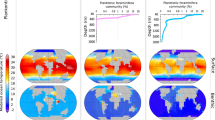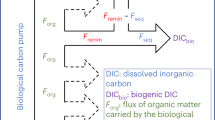Abstract
The ‘snowball Earth’ hypothesis posits the occurrence of a sequence of glaciations in the Earth’s history sufficiently deep that photosynthetic activity was essentially arrested. Because the time interval during which these events are believed to have occurred immediately preceded the Cambrian explosion of life, the issue as to whether such snowball states actually developed has important implications for our understanding of evolutionary biology. Here we couple an explicit model of the Neoproterozoic carbon cycle to a model of the physical climate system. We show that the drawdown of atmospheric oxygen into the ocean, as surface temperatures decline, operates so as to increase the rate of remineralization of a massive pool of dissolved organic carbon. This leads directly to an increase of atmospheric carbon dioxide, enhanced greenhouse warming of the surface of the Earth, and the prevention of a snowball state.
This is a preview of subscription content, access via your institution
Access options
Subscribe to this journal
Receive 51 print issues and online access
$199.00 per year
only $3.90 per issue
Buy this article
- Purchase on Springer Link
- Instant access to full article PDF
Prices may be subject to local taxes which are calculated during checkout






Similar content being viewed by others
References
Kirschvink, J. L. in The Proterozoic Biosphere: A Multi-Disciplinary Study (eds Schopf, J. W. & Klein, C.) 51–52 (Cambridge Univ. Press, Cambridge, UK, 1992)
Kaufman, A. J. An ice age in the tropics. Nature 386, 227–228 (1997)
Hoffman, P. F., Kaufman, A. J., Halverson, G. P. & Schrag, D. P. A Neoproterozoic Snowball Earth. Science 281, 1342–1346 (1998)
Hoffman, P. F. & Schrag, D. P. The snowball Earth hypothesis: testing the limits of global change. Terra Nova 14, 129–155 (2002)
Runnegar, B. Loophole for snowball Earth. Nature 405, 403–404 (2000)
Knoll, A. H. Life on a Young Planet: The First Three Billion Years of Evolution on Earth 1–277 (Princeton Univ. Press, Princeton, New Jersey, 2003)
Hyde, W. T., Crowley, T. J., Baum, S. K. & Peltier, W. R. Neoproterozoic “Snowball Earth” simulations with a coupled climate/ice-sheet model. Nature 405, 425–429 (2000)
Peltier, W. R., Tarasov, L., Vettoretti, G. & Solheim, L. P. in The Extreme Proterozoic: Geology, Geochemistry and Climate (eds Jenkins, G. S. et al.) Geophys. Monogr. Ser. 146, 107–124 (AGU Press, Washington DC, 2004)
Rothman, D. H., Hayes, J. M. & Summons, R. E. Dynamics of the Neoproterozoic carbon cycle. Proc. Natl Acad. Sci. USA 100, 8124–8129 (2003)
Allen, P. A. Snowball Earth on trial. Eos 87, 495 (2006)
Moczydlowska, M. Neoproterozoic and Cambrian successions deposited on the east European platform and Cadomian basement area of Poland. Stud. Geophys. Geodaetica 39, 276–285 (1995)
Grey, K. & Corkoran, M. Late Neoproterozoic stromatolites in glacigenic successions of the Kimberley region, Western Australia: evidence for a younger Marinoan glaciation. Precambr. Res. 92, 65–87 (1998)
Chandler, M. A. & Sohl, L. E. Climate forcings and the initiation of low-latitude ice sheets during the Neoproterozoic Varanger glacial interval. J. Geophys. Res. 105, 20737–20756 (2000)
Goodman, J. C. & Pierrehumbert, R. T. Glacial flow of floating marine ice in “Snowball Earth”. J. Geophys. Res. 108 doi: 10.1029/2002JC001471 (2003)
Poulsen, C. J. & Jacob, R. L. Factors that inhibit snowball Earth simulation. Paleoceanography 19 doi: 10.1029/2004PA001056 (2004)
Donnadieu, Y., Goddéris, Y., Ramstein, G., Nédélec, A. & Meert, J. A. “Snowball Earth” triggered by continental breakup through changes in runoff. Nature 428, 303–306 (2004)
Pollard, D. & Kasting, J. F. Snowball Earth: a thin ice solution with flowing sea glaciers. J. Geophys. Res. 110 doi: 10.1029/2004JC002525 (2005)
Pierrehumbert, R. T. Climate dynamics of a hard snowball Earth. J. Geophys. Res. 110 doi: 10.1029/2004JD0005162 (2005)
Leather, J., Allen, P. A., Brasier, M. D. & Cozzi, A. Neoproterozoic snowball Earth under scrutiny: Evidence from the Fiq glaciation of Oman. Geology 30, 891–894 (2002)
Le Guerroué, E., Allen, P. A. & Cozzi, A. Chemostratigraphic and sedimentological framework of the largest negative carbon isotopic excursion in Earth history: The Neoproterozoic Shuram formation (Nafun Group, Oman). Precambr. Res. 146, 68–92 (2006)
Allen, P. A., Leather, J. & Brasier, M. D. The Neoproterozoic Fiq glaciation and its aftermath: Huqf Supergroup of Oman. Basin Res. 16, 507–534 (2004)
Condon, D. et al. U-Pb ages from the Neoproterozoic Doushantuo formation, China. Science 308, 95–98 (2005)
Halverson, G. P., Hoffman, P. F., Schrag, D. P., Maloof, A. C. & Rice, A. H. N. Towards a Neoproterozoic composite carbon cycle isotopic record. Geol. Soc. Am. Bull. 117, 1181–1207 (2005)
Hoffman, P. F. & Schrag, D. P. Snowball Earth. Sci. Am. 282, 68–75 (2000)
Eyles, N. & Januszczak, N. “Zipper-Rift”: A tectonic model for Neoproterozoic glaciations during the breakup of Rodinia after 750 Ma. Earth Sci. Rev. 65, 1–73 (2004)
Schrag, D. P. & Hoffman, P. F. Life, geology, and snowball Earth. Nature 9, 306 (2001)
Tarasov, L. & Peltier, W. R. Arctic freshwater forcing of the Younger-Dryas cold reversal. Nature 435, 662–665 (2005)
Kump, L. R. & Arthur, M. A. Interpreting carbon-isotope excursions: carbonates and organic matter. Chem. Geol. 161, 181–198 (1999)
Ramanathan, V., Lian, M. S. & Cess, R. D. Increasing atmospheric CO2: zonal and seasonal estimates of the effect on the radiation energy balance and surface temperature. J. Geophys. Res. 84, 4949–4958 (1979)
Marshall, H. G., Walker, J. C. G. & Kuhn, W. R. Long-term climate change and the geochemical cycle of carbon. J. Geophys. Res. 93, 791–801 (1988)
Pierrehumbert, R. T. High levels of atmospheric carbon dioxide necessary for the termination of global glaciation. Nature 429, 646–649 (2004)
Christie-Blick, N., von der Borch, C. C. & Dibona, P. A. Working hypotheses for the origin of the Wonoka canyons (Neoproterozoic), South Australia. Am. J. Sci. A 290, 295–332 (1990)
Christie-Blick, N., Williams, G. E. & Gostin, V. A. Discussion on mantle plume uplift in the sedimentary record: Origin of kilometre-deep canyons within late Neoproterozoic successions, South Australia. J. Geol. Soc. 158, 573–576 (2001)
Peltier, W. R. & Fairbanks, R. G. Global glacial ice volume and Last Glacial Maximum duration from an extended Barbados sea level record. Quat. Sci. Rev. 25, 3322–3337 (2006)
Fike, D. A., Grotzinger, J. P., Pratt, L. M. & Summons, R. E. Oxidation of the Ediacaran ocean. Nature 444, 744–747 (2006)
Bidigare, R. R. et al. Consistent fractionation of 13C in nature and in the laboratory: growth-rate effects in some haptophyte algae. Glob. Biogeochem. Cycles 11, 279–292 (1997)
Walker, J. C. G., Hays, P. B. & Kasting, J. F. A negative feedback mechanism for the long term stabilization of earth’s surface temperature. J. Geophys. Res. 86, 9776–9782 (1981)
Berner, R. A., Lasaga, A. C. & Garrels, R. M. The carbonate-silicate geochemical cycle and its effect on atmospheric carbon dioxide over the past 100 million years. Am. J. Sci. 283, 641–683 (1983)
Berner, R. A. The Phanerozoic Carbon Cycle: CO2 and O2 1–150 (Oxford Univ. Press, Oxford, UK, 2004)
Garcia, H. E. & Gordon, L. I. Oxygen solubility in sea water: Better fitting equations. Limnol. Oceanogr. 37, 1307–1312 (1992)
Poulsen, C. J., Pierrehumbert, R. T. & Jacob, R. L. Impact of ocean dynamics on the simulation of the Neoproterozoic “snowball Earth”. Geophys. Res. Lett. 28 doi: 10.1029/2000GL012058 (2001)
North, G. R., Mengel, J. G. & Short, D. A. Simple energy balance model resolving the seasons and continents: application to the astronomical theory of the ice ages. J. Geophys. Res. 88, 6576–6586 (1983)
Deblonde, G., Peltier, W. R. & Hyde, W. T. Simulations of continental ice sheet growth over the last glacial-interglacial cycle: experiments with a one level seasonal energy balance model including seasonal ice albedo feedback. Glob. Planet. Change 98, 37–55 (1992)
Peltier, W. R. Postglacial variations in the level of the sea: implications for climate dynamics and solid-earth geophysics. Rev. Geophys. 36, 603–689 (1998)
Butler, S. L., Peltier, W. R. & Costin, S. O. Numerical models of the earth’s thermal history: Effects of inner core solidification and core potassium. Phys. Earth Planet. Inter. 152, 22–42 (2005)
Hyde, W. T., Crowley, T. J., Tarasov, L. & Peltier, W. R. The Pangean ice-age: Studies with a coupled climate-ice sheet model. Clim. Dyn. 15, 619–629 (1999)
Hyde, W. T., Grossman, E. L., Crowley, T. J., Pollard, D. & Scotese, C. R. Siberian glaciation as a constraint on Permian-Carboniferous CO2 levels. Geology 34, 421–424 (2006)
Berner, R. A. GEOCARBSULF: A combined model for Phanerozoic atmospheric O2 and CO2 . Geochim. Cosmochim. Acta 70, 5653–5664 (2006)
Acknowledgements
This paper is a contribution to the Polar Climate Stability Network, which is sponsored by the Canadian Foundation for Climate and Atmospheric Science and a consortium of Canadian universities. Additional assistance was provided by the Natural Sciences and Engineering Research Council of Canada.
Author information
Authors and Affiliations
Corresponding author
Supplementary information
Supplementary Information
The file contains Supplementary Notes which provide a detailed mathematical derivation of the Carbon Cycle model as well as a discussion of the settings employed for the initial values of the parameters of the model. Figures S1 and S2 display time series of land ice volume for X=1 and X=2 respectively, both figures demonstrating the trend of increasing period as the value of the control parameter F21 decreases. Figure S3 illustrates the phase relationships between 6 different (normalized) field variables of the model whereas Figure S4 is similar to Figure 6 in the main body of the paper but is based upon the predictions of the model for X = 1. (PDF 1199 kb)
Rights and permissions
About this article
Cite this article
Peltier, W., Liu, Y. & Crowley, J. Snowball Earth prevention by dissolved organic carbon remineralization. Nature 450, 813–818 (2007). https://doi.org/10.1038/nature06354
Received:
Accepted:
Issue Date:
DOI: https://doi.org/10.1038/nature06354
This article is cited by
-
Spatiotemporal variability in the optical characteristics of dissolved organic matter in the coastal Bay of Bengal
International Journal of Environmental Science and Technology (2022)
-
Snowfall-albedo feedbacks could have led to deglaciation of snowball Earth starting from mid-latitudes
Communications Earth & Environment (2021)
-
A Review of the Neoproterozoic Global Glaciations and a Biotic Cause of Them
Earth Systems and Environment (2021)
-
Abrupt climate transition of icy worlds from snowball to moist or runaway greenhouse
Nature Geoscience (2017)
-
Strong effects of tropical ice-sheet coverage and thickness on the hard snowball Earth bifurcation point
Climate Dynamics (2017)
Comments
By submitting a comment you agree to abide by our Terms and Community Guidelines. If you find something abusive or that does not comply with our terms or guidelines please flag it as inappropriate.



